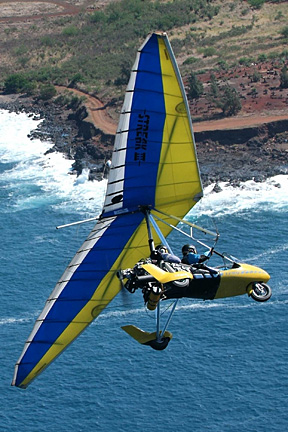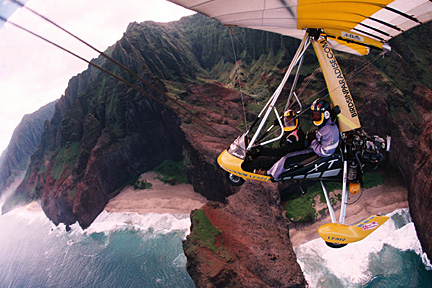
|
Hawaii’s
Back Yard |
A bird’s eye view
of Hawaii
Gerry Charlebois describes the Microlight powered hang glider as "a high-performance motorcycle with wings."Charlebois, 46, is the president of Birds in Paradise Powered Hang Gliding Flight School on Kauai. Strapped securely in the aircraft's open cockpit, he and a student can attain an altitude of 7,000 feet and a cruising speed of more than 70 miles per hour with nothing between them and the beauty of nature.
"Looking at the endless ocean and sky, and at these deep valleys and sheer cliffs you feel very small and insignificant," Charlebois says. "There are no stoplights or traffic to hold you back. It gives you a total sense of freedom. You can glide for an hour or two without stopping, and all the time you're up there, you're smiling. One of the common complaints I receive from customers is that their cheeks hurt after a flight from constantly smiling!"
Microlight is an international term used for weight-shift aircraft, including powered hang gliders. To be classified as such, Microlights should have a fuel capacity of no more than 10 gallons, not exceed a speed of 75 miles per hour and weigh no more than 525 pounds with a parachute. U.S. regulations stipulate that Microlights must not operate over congested areas and must not fly before sunrise or after sunset.
Charlebois' Microlight -- an Australian-built Airborne 912XT Trike -- is propelled by an 82-horsepower engine that he says is "super quiet" and burns just 2.5 gallons per hour. It's equipped with all the latest backup parachute systems, an emergency locator transmitter, global positioning system, and aircraft and personal flotation devices.
"Its power-to-weight ratio is double that of a small plane," Charlebois asserts. "That means carrying two people, it climbs an average of 1,200 feet per minute. Most elevators go up 250 feet per minute. I fly the fastest light aircraft available on the market."

Soar above Kauai aboard Birds in Paradise's Microlight, which has all the appeal of a hang glider without the constraints.
In 1990, he founded Birds in Paradise using a regular hang glider. He made the switch to the powered hang glider four years later, after being introduced to it in Australia when he was competing in the world hang gliding championship.
"From the first time I tried it, I was hooked," Charlebois says. "It has far less constraints than a regular hang glider because it doesn't rely on the wind to stay aloft. Also, you can pilot it from either the front or back seat and it's more comfortable because the occupants are sitting upright as opposed to lying in a horizontal pod. It requires no participation of the passenger during takeoff or landing, making it safer for both of us."
Best of all, the Airborne Trike is easy to operate. "It has dual controls and steers much like a cross between a shopping cart and a bike," Charlebois explains. "It's simple; we push up on the control bar to go up, we pull down to go down, we pull left to go left, we pull right to go right. After 15 minutes in the air, most people are able to accelerate, decelerate, gain altitude, do banking turns and even go in circles. Flying a weight-shift aircraft like a Trike is very intuitive."

A lesson with Birds in Paradise Powered Hang Gliding Flight School puts students in the air with a licensed pilot who can take the controls if you just want to stare at the scenery.
"For the first few minutes after take off, while I deal with radio communication with other aircraft, instrumentals relax my student," says Charlebois. "I like to have songs about flying coming over the headsets during portions of the flight.
"The point of an introductory lesson is to not overload students with information, but to get them relaxed and show them how much fun it is to cruise in our motorcycle in the sky!"
Although he doesn't adhere to any set flight patterns and doesn't guarantee one, Charlebois flies almost everywhere on Kauai as long as time and conditions allow. "Customers can request where they want to go, and if the weather is good we'll go there," he says. "Kauai is only 25 by 35 miles in size; flying 70-plus miles per hour, we're able to see a lot of it."
His favorite spots include the Napali Coast, Mount Waialeale and Waimea Canyon, from which he usually heads north, going low over a lush forest. "We skim over the treetops really fast," he says, "and as we fly over the edge of Kalalau Valley, the terrain suddenly drops away. The music is soaring and so are we -- 4,000 feet above the ground! Right about then, I usually turn down the volume on my headset so my student doesn't scream in my ear. I look back and his eyes are always as big as saucers!"
One of those awestruck students was a 12-year-old boy who was dying of brain cancer. "The Make-A-Wish Foundation brought him and his family to Kauai so he could go flying with me," Charlebois recalls. "I took him above the clouds, and he exclaimed, 'Wow! (Mom) never told me about this!'
"He explained that his mother had told him that he was going to heaven soon, but she didn't tell him he was going to be able to check it out in a Microlight first. I choked up, but was able to tell him that if this is what heaven looks like, it will be an OK place to go to. Tears really sting at that altitude."
A MEMBER OF the Screen Actors Guild and the American Stuntman's Association, Charlebois is very active in Hawaii's film industry. He has photographed hang gliding and Trike flying for numerous shows, including the Discovery Channel, Travel Channel and "Wild on E!." "I've had many customers tell me that they came to Kauai because they saw my footage on TV," he says.
To date, Charlebois estimates he's shared his love of flying with more then 13,000 people who come from around the globe.
"Some work at Burger King, some are state Supreme Court justices," he says. "But no matter what their background is, every time I take a student out, the most common response is, 'I've always dreamed of flying like a bird! Now I know what it's like -- it's awesome!"
If you go ...
What: Birds in ParadiseMeet at: Port Allen Airport in Hanapepe, about 30 minutes west of Lihue, at least 15 minutes before your departure. Go west from Lihue on Highway 50. Take the 543 turnoff after the 17-mile marker. It is a half-mile to the strip. Continue to Birds in Paradise's headquarters.
Days and times: Four days per week, weather permitting, starting at 7 a.m. The schedule varies; reservations required.
Cost: Choose from the 30-minute mini introductory lesson ($115), the 60-minute standard introductory lesson ($190), the 90-minute advanced lesson ($270) and the two-hour advanced round-the-island lesson, which includes a landing or two ($360). No experience required; longer flights give you more cross-country flying time. You can earn Microlight pilot certification with Birds in Paradise; the price is based on the time involved (typically 10 to 12 hours). A roll of 24 photos taken by a wing-mounted camera during your flight costs $25; a 60-minute DVD of your flight is $60.
Call: (808) 822-5309
E-mail: birds@birdsinparadise.com
Web site: www.birdsinparadise.com
Notes: Individuals must be at least 12 years old and weigh no more than 275 pounds to fly with Birds in Paradise. Wear socks and closed-toe shoes; helmets and flight suits are provided. Paradise Air based at Dillingham Airfield on Oahu (497-6033; www.paradiseairhawaii.com) and Hang Gliding Maui in Hana (808/893-0750; www.www.hangglidingmaui.com) offer the same service using the same aircraft.
E-mail to Travel Desk
[News] [Business] [Features] [Sports] [Editorial] [Do It Electric!]
[Classified Ads] [Search] [Subscribe] [Info] [Letter to Editor]
[Feedback]
